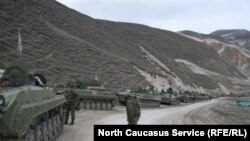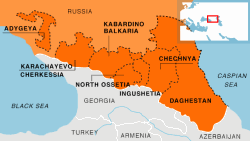Reports of the deployment to Daghestan of some 20,000 Russian troops from the Russian military base at Khankala on the outskirts of Grozny have elicited contradictory comments from senior regional officials. The purpose of the deployment remains unclear.
The deployment was reported late on March 17 by the independent website Kavkaz-Uzel and by Kavkaz Center, the official mouthpiece of the North Caucasus insurgency.
Kavkaz Center claimed the contingent numbered some 25,000 men plus a column of armored vehicles that was 10-15 kilometers long.
It said the contingent took up positions in the districts of Karabudakhkent, south-east of Makhachkala, and Sergokala, which borders on Karabudakhkent to the south.
Kavkaz-Uzel quoted residents from the Chechen town of Gudermes, which the armored column passed through, and a village in Karabudakhkent as saying they had “never seen anything like it.”
Kavkaz-Uzel also quoted an unidentified representative of Daghestan’s law enforcement and security agencies as saying the deployment was occasioned by the deterioration in the security situation in Daghestan, which over the past two years has replaced Ingushetia as the region where the North Caucasus insurgency is most active.
The same official said the Russian Interior Ministry has decided to establish in Daghestan a Temporary Operative Grouping of Interior Ministry sub-units like the one that exists in Chechnya. The grouping will be headed by police Major Oleg Kizhayev.
'Routine Rotation'
Daghestan Security Council Secretary Magomed Baachilov, however, said the troops had been sent to Daghestan from Chechnya as part of a routine rotation, to replace Interior Ministry troops sent to Daghestan from elsewhere in the Russian Federation for a normal tour of duty lasting three to six months.
Baachilov gave a far lower figure than Kavkaz-Uzel initially reported: between 500 and 1,000 men.
Baachilov also said the newly-arrived servicemen will form temporary units.
These will cooperate with the seven recently formed Daghestan Interior Ministry Special Operative Groups, which are to focus exclusively on combating the insurgency, freeing up the regular police to concentrate on fighting routine crime.
But Daghestani journalist Magomed Khanmagomedov, who writes for the independent weekly “Chernovik,” told Kavkaz-Uzel thatthe contingent in question are not Interior Ministry but Defense Ministry troops.
He linked the deployment to growing tensions surrounding Iran.
Chechen Denial
For his part, Chechen leader Ramzan Kadyrov issued a formal statement denying that any Chechen Interior Ministry troops had been sent to Daghestan.
Kadyrov described the media reports of such a deployment as a shameless lie circulated by “those who covertly or openly sympathize with participants in illegal armed formations and are concerned by the possibility that they may be neutralized.”
Chechen Interior Ministry troops have been deployed to Daghestan in the past to perform duties that the local police were considered incapable of discharging, notably providing security for Russian President Dmitry Medvedev’s visit to Makhachkala two years ago.
If the intended purpose of the recent deployment is to crush the Daghestan wing of the insurgency, which is currently without a leader following the killing last month of Ibragimkhalil Daudov (Amir Salikh), then Baachilov’s figure of 500-1,000 men seems insufficient.
And if the figure of more than 20,000 cited by Kavkaz Center and Kavkaz-Uzel is true, then it does not appear sensible to concentrate them all in Karabudakhkent and Sergokala.
True, those two districts form part of the zig-zag arc of instability that extends from Kizlyar in the north to Khasavyurt on the border with Chechnya , then south-east via Kizilyurt to Makhachkala, then south to Kaspiisk, southwest to Untsukul, then again south-east to Derbent.
But in recent months there have been at least as many, possibly more, armed clashes elsewhere, in Kizylar and Khasavyurt.
The deployment was reported late on March 17 by the independent website Kavkaz-Uzel and by Kavkaz Center, the official mouthpiece of the North Caucasus insurgency.
Kavkaz Center claimed the contingent numbered some 25,000 men plus a column of armored vehicles that was 10-15 kilometers long.
It said the contingent took up positions in the districts of Karabudakhkent, south-east of Makhachkala, and Sergokala, which borders on Karabudakhkent to the south.
Kavkaz-Uzel quoted residents from the Chechen town of Gudermes, which the armored column passed through, and a village in Karabudakhkent as saying they had “never seen anything like it.”
Kavkaz-Uzel also quoted an unidentified representative of Daghestan’s law enforcement and security agencies as saying the deployment was occasioned by the deterioration in the security situation in Daghestan, which over the past two years has replaced Ingushetia as the region where the North Caucasus insurgency is most active.
The same official said the Russian Interior Ministry has decided to establish in Daghestan a Temporary Operative Grouping of Interior Ministry sub-units like the one that exists in Chechnya. The grouping will be headed by police Major Oleg Kizhayev.
'Routine Rotation'
Daghestan Security Council Secretary Magomed Baachilov, however, said the troops had been sent to Daghestan from Chechnya as part of a routine rotation, to replace Interior Ministry troops sent to Daghestan from elsewhere in the Russian Federation for a normal tour of duty lasting three to six months.
Baachilov gave a far lower figure than Kavkaz-Uzel initially reported: between 500 and 1,000 men.
Baachilov also said the newly-arrived servicemen will form temporary units.
These will cooperate with the seven recently formed Daghestan Interior Ministry Special Operative Groups, which are to focus exclusively on combating the insurgency, freeing up the regular police to concentrate on fighting routine crime.
But Daghestani journalist Magomed Khanmagomedov, who writes for the independent weekly “Chernovik,” told Kavkaz-Uzel thatthe contingent in question are not Interior Ministry but Defense Ministry troops.
He linked the deployment to growing tensions surrounding Iran.
Chechen Denial
For his part, Chechen leader Ramzan Kadyrov issued a formal statement denying that any Chechen Interior Ministry troops had been sent to Daghestan.
Kadyrov described the media reports of such a deployment as a shameless lie circulated by “those who covertly or openly sympathize with participants in illegal armed formations and are concerned by the possibility that they may be neutralized.”
Chechen Interior Ministry troops have been deployed to Daghestan in the past to perform duties that the local police were considered incapable of discharging, notably providing security for Russian President Dmitry Medvedev’s visit to Makhachkala two years ago.
If the intended purpose of the recent deployment is to crush the Daghestan wing of the insurgency, which is currently without a leader following the killing last month of Ibragimkhalil Daudov (Amir Salikh), then Baachilov’s figure of 500-1,000 men seems insufficient.
And if the figure of more than 20,000 cited by Kavkaz Center and Kavkaz-Uzel is true, then it does not appear sensible to concentrate them all in Karabudakhkent and Sergokala.
True, those two districts form part of the zig-zag arc of instability that extends from Kizlyar in the north to Khasavyurt on the border with Chechnya , then south-east via Kizilyurt to Makhachkala, then south to Kaspiisk, southwest to Untsukul, then again south-east to Derbent.
But in recent months there have been at least as many, possibly more, armed clashes elsewhere, in Kizylar and Khasavyurt.


